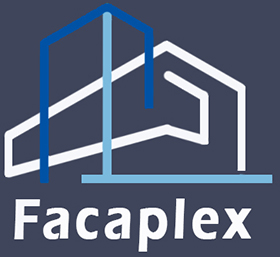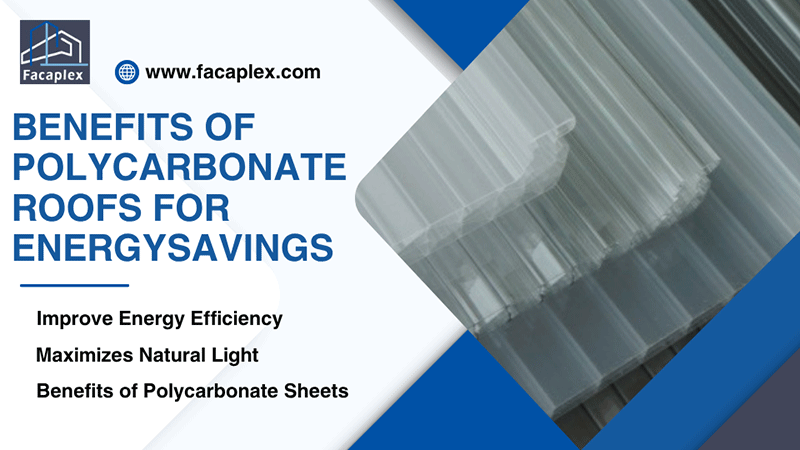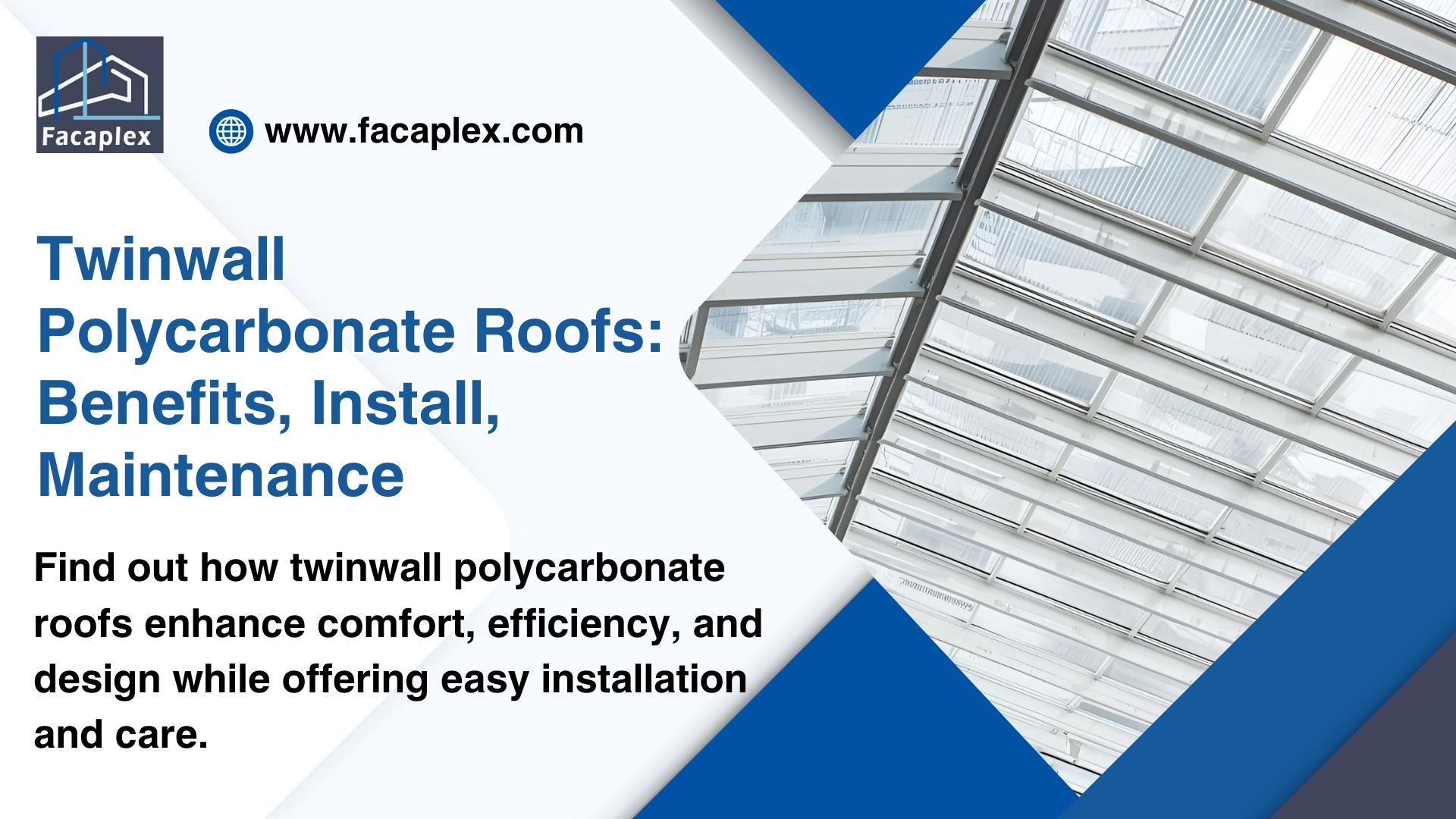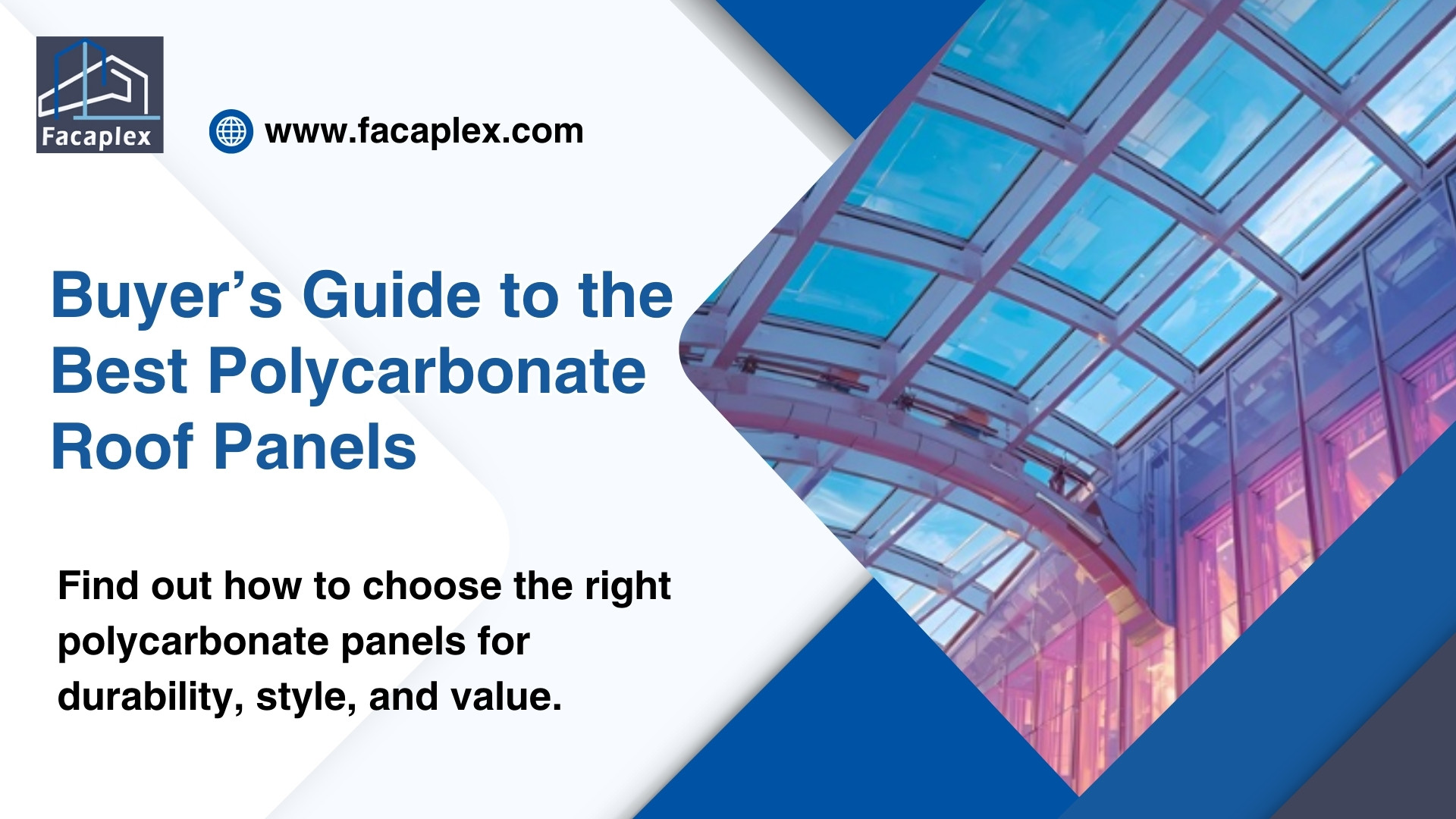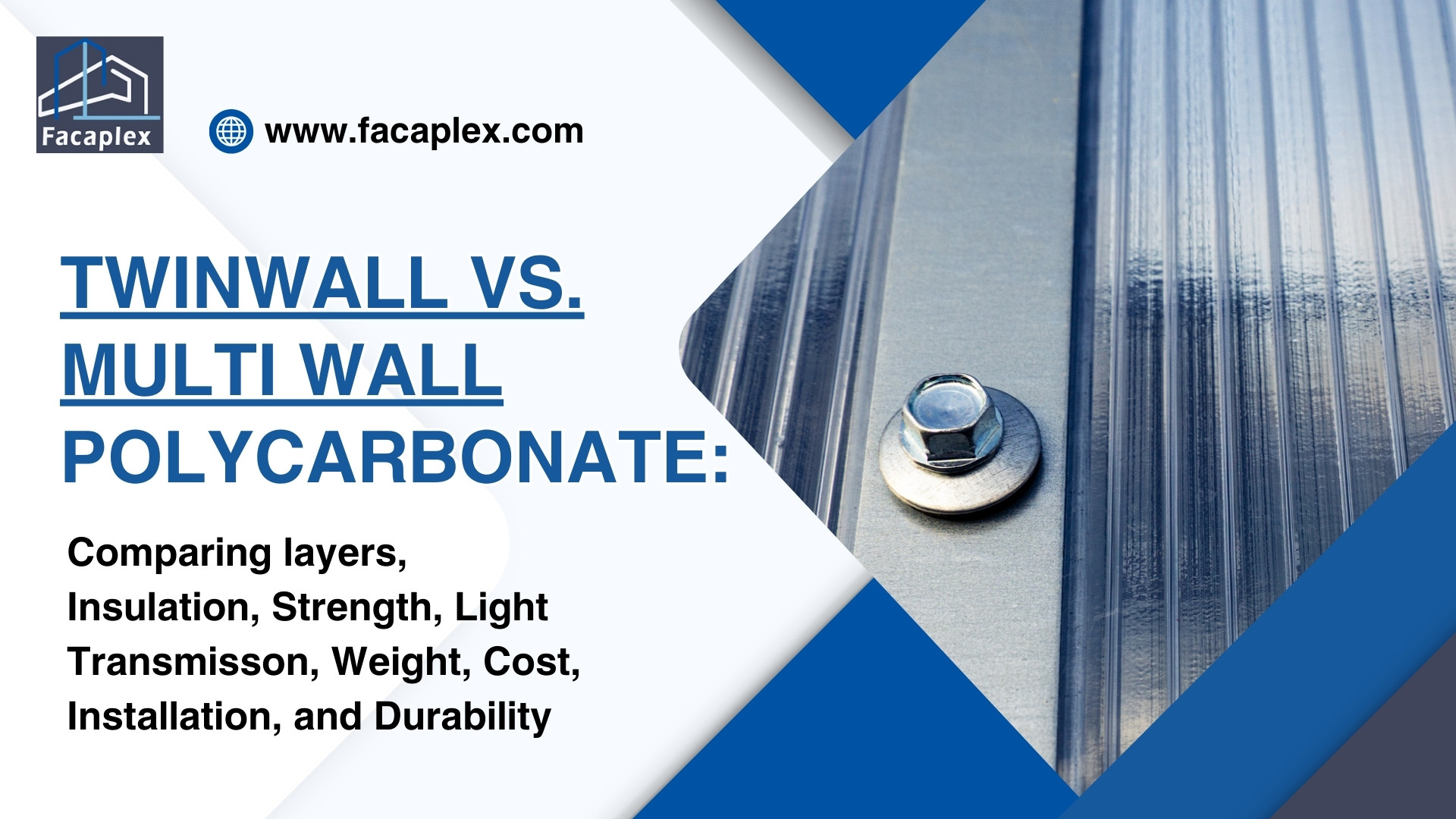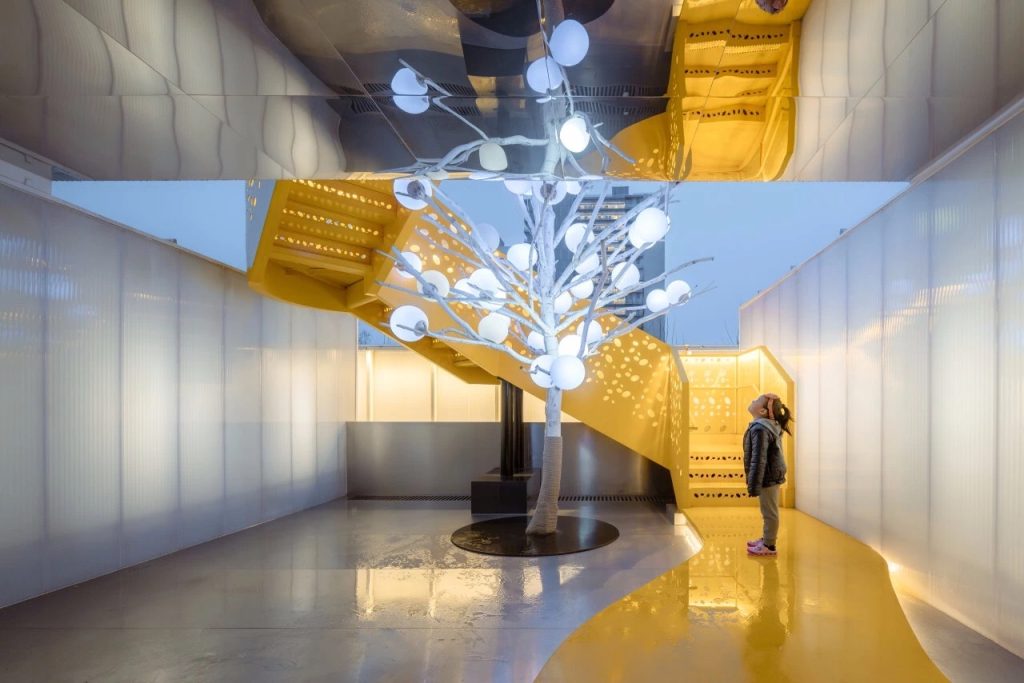Polycarbonate roofs deliver measurable energy savings by combining advanced insulation with exceptional light transmission. Recent studies show that a 16 mm triple 5-wall polycarbonate sheet can reduce annual cooling energy consumption by up to 44% compared to traditional materials. Polycarbonate roofs excel in both residential and commercial spaces, offering benefits such as lower heating and cooling costs. These polycarbonate roofs allow more natural daylight, which reduces the need for artificial lighting and supports energy-efficient building design. Many architects choose polycarbonate roofs for their proven efficiency and commitment to sustainability.
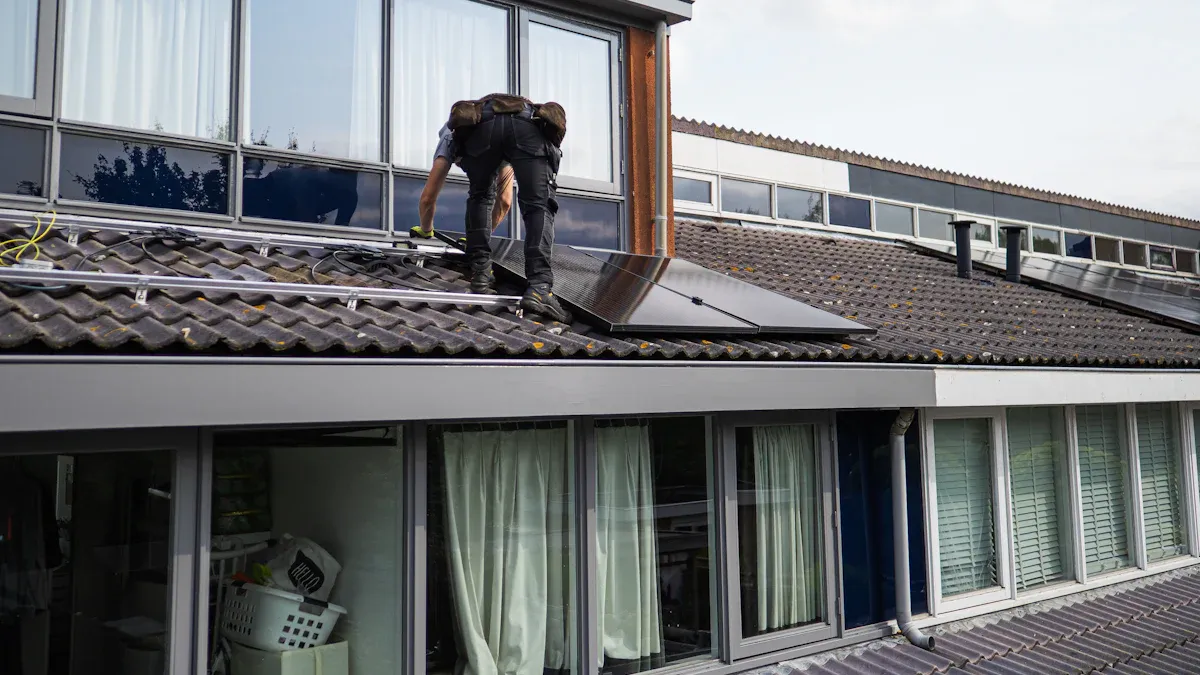
Polycarbonate roofs improve energy efficiency
Insulation benefits of polycarbonate roofing
Polycarbonate roofing stands out for its exceptional thermal insulation, which plays a crucial role in energy conservation. The multiwall structure of these roofs features several layers separated by air pockets. These air pockets act as natural insulators, significantly reducing heat transfer between the interior and exterior environments. This design helps maintain stable indoor temperatures, regardless of outdoor weather conditions.
Polycarbonate roofing exhibits a lower U-value compared to fiberglass and glass, indicating superior resistance to heat transfer. For example, polycarbonate panels can have a K-value as low as 0.21, while traditional glass measures around 0.96. This substantial difference means polycarbonate roofs retain heat more effectively in winter and block excess heat during summer.
The thermoplastic nature of polycarbonate roofing also contributes to its flexibility and durability. These properties allow the material to withstand harsh weather while maintaining its insulation performance over time. UV-resistant coatings further enhance the benefits of polycarbonate roofing by protecting against solar radiation and preserving insulation quality.
- The multiwall polycarbonate sheets create multiple air pockets that act as natural thermal insulators.
- These air pockets reduce heat transfer compared to single-layer materials.
- Improved thermal performance helps maintain warmer interiors in cold weather and cooler spaces in hot climates.
- UV-resistant coatings ensure long-term insulation performance and energy savings.
This advanced structure not only supports energy efficiency in buildings but also aligns with modern sustainability goals.
Reduced heating and cooling costs
The superior insulation properties of polycarbonate roofing directly translate into lower HVAC costs for both residential and commercial buildings. By minimizing heat loss in winter and reducing heat gain in summer, these roofs decrease the demand on heating and cooling systems.
A variety of real-world examples highlight the impact of polycarbonate roofing on energy bills:
- A manufacturing facility in Texas achieved a 25% reduction in cooling costs after installing polycarbonate baseplates with turbo ventilators.
- A commercial office building in Singapore reported a 15% decrease in overall energy consumption after integrating polycarbonate-based cooling solutions.
- Residential homes with polycarbonate roofs benefit from enhanced natural light and consistent indoor temperatures, leading to noticeable energy savings year-round.
Polycarbonate roofs offer a clear advantage over traditional materials by combining high light transmission with outstanding insulation. This dual benefit reduces reliance on artificial lighting and HVAC systems, which supports energy efficiency and sustainability in building design.
| Feature | Polycarbonate Roofing | Galvanized Metal Roofing | Thatched Roofing |
|---|---|---|---|
| Weight | Lightweight | Heavy | Light |
| UV Resistance | Excellent | Low | Poor |
| Lifespan | 10–20 years | 10–15 years | 5–8 years |
| Fire Resistance | Moderate | Excellent | Very Poor |
| Transparency | Up to 90% | Opaque | Partial shade |
| Cost | Moderate | Low–Moderate | Very Low |
This table demonstrates that polycarbonate roofs excel in energy efficiency, durability, and UV resistance. Their lightweight nature also reduces structural load, which can further lower construction and operational costs.
The benefits of polycarbonate roofing extend beyond immediate energy savings. As more architects and builders prioritize energy efficiency in buildings, polycarbonate roofs continue to gain popularity for their ability to deliver long-term value and support sustainable construction practices.
Polycarbonate roofing maximizes natural light
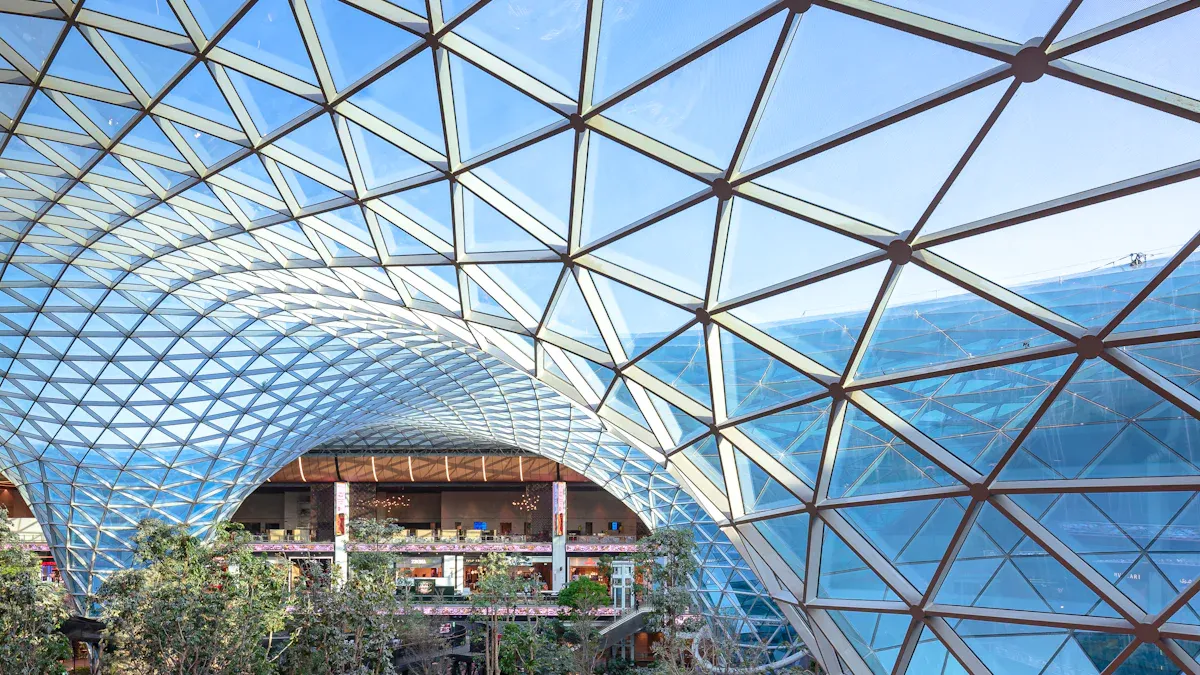
Lower need for artificial lighting
Polycarbonate roofing panels stand out for their exceptional transparency and light diffusion. These panels allow approximately 85% to 88% of visible light to pass through, a rate comparable to clear float glass and far superior to metal roofing, which blocks natural light entirely. As a result, polycarbonate roofs create bright, well-lit interiors throughout the day. This high level of natural daylighting means building occupants can turn off or dim electric lights, leading to lower artificial lighting usage and significant energy savings.
Natural daylighting from polycarbonate roofing benefits both commercial and residential spaces. In offices, warehouses, and homes, the increased daylight reduces energy consumption and improves indoor environments. Polycarbonate skylights and sidelights often work with sensors that automatically adjust electric lighting based on available sunlight. This approach not only saves energy but also supports occupant well-being and productivity. The lightweight and durable nature of polycarbonate roofing makes it a preferred choice for daylighting systems, helping buildings meet modern efficiency standards.
*Tip: Maximizing daylight with polycarbonate roofing can help projects earn sustainability credits and comply with stricter energy codes.
Consistent indoor temperatures
Polycarbonate roofing does more than brighten interiors. Its advanced design helps maintain stable indoor temperatures year-round. The multiwall structure and air gaps in polycarbonate roofing provide effective thermal insulation. This insulation keeps buildings cool in summer and warm in winter, reducing the need for heating and cooling.
UV-blocking properties further enhance indoor comfort. Polycarbonate roofing panels filter out harmful ultraviolet rays while allowing visible light to enter. This feature prevents heat buildup and glare, creating a comfortable environment without the risk of sunburn or eye strain. The UV protection also preserves the clarity and durability of the panels, ensuring long-lasting performance and efficiency.
A sustainable building project using polycarbonate roofs demonstrated reduced heat gain during summer and minimized heat loss in winter. The result was consistent indoor comfort and lower energy bills. These benefits make polycarbonate roofing an excellent solution for spaces that require constant temperature control, such as greenhouses and conservatories.
Environmental benefits of polycarbonate sheets
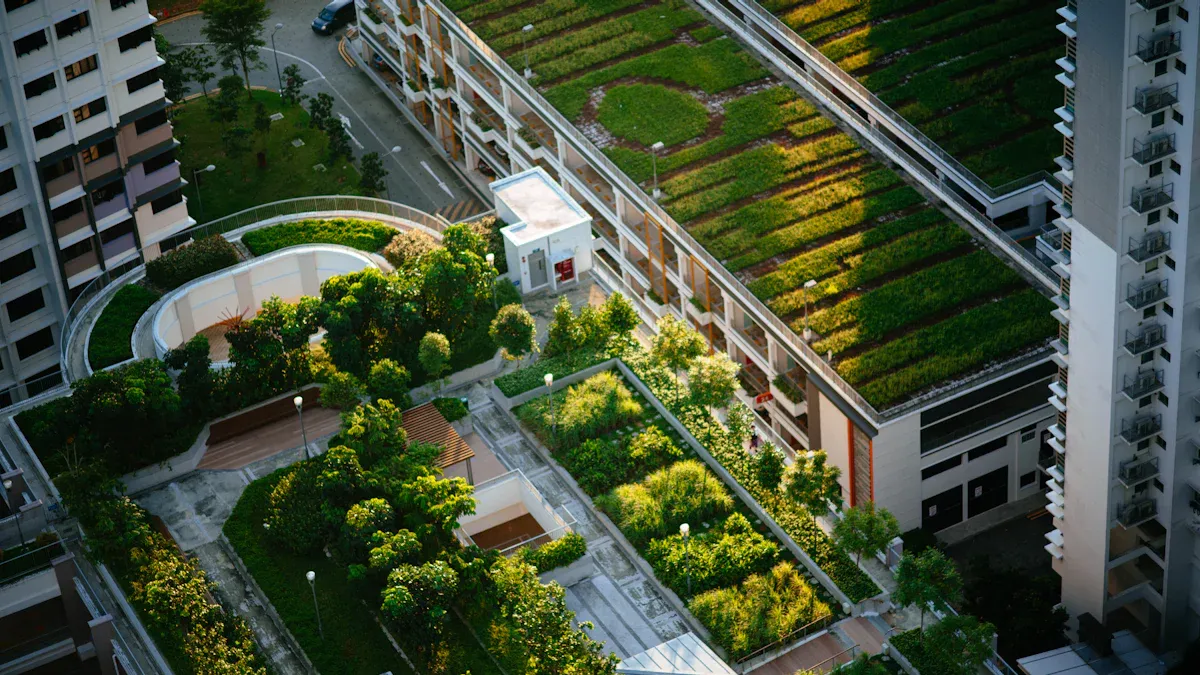
Reduced carbon footprint
Polycarbonate roofing offers significant environmental benefits of polycarbonate sheets by lowering the carbon footprint of buildings. The lightweight nature of polycarbonate sheets reduces transportation emissions and energy use during installation. Their advanced thermal insulation properties help buildings use less energy for heating and cooling, which leads to lower greenhouse gas emissions over time. Polycarbonate’s durability and long lifespan mean fewer replacements, which reduces resource consumption and waste.
- Polycarbonate sheets improve building energy efficiency by reducing HVAC energy use by up to 30%.
- Multiwall designs cut heat transfer by up to 50%, keeping interiors comfortable with less energy.
- Their transparency allows more natural light, which decreases the need for artificial lighting and further reduces energy consumption.
- Innovations in recycled and bio-based content lower emissions from raw materials.
A comparison with traditional roofing materials shows clear advantages. Polycarbonate sheets weigh about 50% less than glass, which means less energy is needed for transport and installation. Over a 10-year period, polycarbonate requires 80% less maintenance energy than aluminum. These factors combine to make polycarbonate roofing a strong choice for green building practices.
| Aspect | Polycarbonate Sheets | Other Roofing Materials (Glass, Wood, Aluminum) |
|---|---|---|
| HVAC Energy Savings | 15-30% reduction | Less efficient, higher energy use |
| Weight | 50% lighter than glass | Heavier, more transport energy |
| Maintenance Energy | 80% less than aluminum | Higher for wood, metal, glass |
| Lifespan | 15-25 years | Shorter for wood, glass, metal |
Recyclability and sustainability
The environmental benefits of polycarbonate sheets extend to recyclability and sustainability. Polycarbonate roofing is fully recyclable, which supports a circular economy and reduces landfill waste. Using recycled polycarbonate in roofing products greatly lowers energy demand and nearly eliminates carbon emissions during production. This improvement in sustainability makes polycarbonate an ideal material for green building practices.
Many polycarbonate roofing products meet strict environmental certifications. These include ISO 14001 for environmental management, the Global Recycling Standard, and Green Seal, which is recognized worldwide for health and environmental leadership. Polycarbonate roofs also help buildings earn credits in green building programs like LEED and BREEAM by maximizing daylight, reducing energy use, and supporting water management systems.
*Tip: Choosing polycarbonate roofing helps projects meet sustainability goals and supports a healthier environment for future generations.
The environmental benefits of polycarbonate sheets make them a smart choice for builders who want to reduce their carbon footprint and support sustainable construction.
Practical benefits of polycarbonate roofs
Durability and low maintenance
Polycarbonate roofs deliver long-term value through outstanding durability and minimal maintenance needs. These panels resist impact, UV rays, and harsh weather, making them less likely to suffer damage from hail or temperature swings. Their robust construction means fewer repairs and replacements over time, which leads to significant cost savings. Many building owners choose polycarbonate roofs because they do not require frequent inspections or specialized cleaning. Regular cleaning with water is usually enough to keep them in top condition.
The benefits of polycarbonate roofing include high impact resistance and protection against mold and mildew. Unlike asphalt shingles or clay tiles, polycarbonate panels do not warp, crack, or leak easily. This reliability reduces the need for ongoing repairs and helps maintain a building’s appearance and performance for years.
| Roofing Material | Durability Features | Maintenance Requirements | Comparative Notes |
|---|---|---|---|
| Polycarbonate Roofing | High impact resistance, UV protection, weatherproof | Minimal; regular cleaning | Long lifespan, low upkeep, cost-effective over time |
| Asphalt Shingles | Prone to weather damage, warping, leaks | Frequent repairs and replacements | Higher long-term maintenance costs |
| Metal Roofing | Durable, but can rust or corrode | Regular painting and coating | Maintenance costs rise without preventative care |
| Concrete Tiles | Heavy, may crack or sag | Frequent attention needed | Additional structural support increases complexity |
*Polycarbonate roofing stands out as a maintenance-free and cost-effective solution, offering a lifespan of 20 years or more.
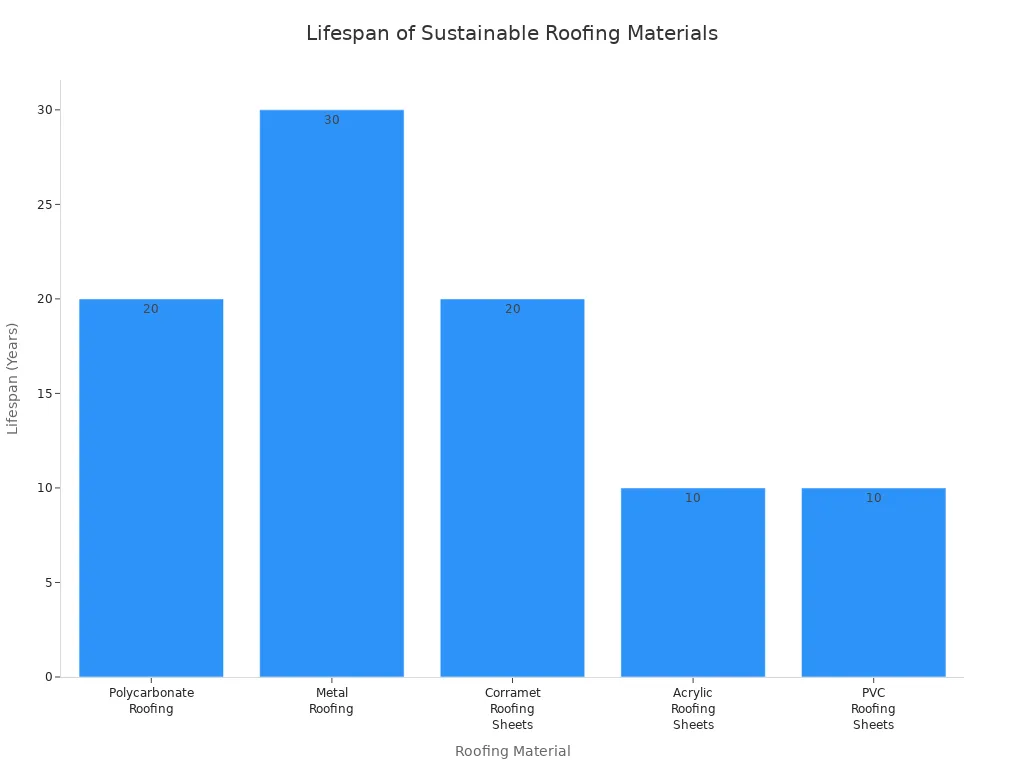
Lightweight and easy installation
Polycarbonate roofs offer another key advantage: lightweight construction. A 6mm polycarbonate sheet weighs only about 1.3 to 1.5 kg per square meter. This low weight reduces the load on roof supports, allowing for lighter framing and easier retrofitting. Builders can install these panels quickly, with less manpower and equipment than heavier materials like glass or metal.
The benefits of polycarbonate roofing also include flexibility and versatility. Installers can cut and shape the panels to fit unique designs without heavy lifting or complex tools. This ease of installation saves time and labor costs, making polycarbonate roofs a practical choice for both new construction and renovations.
- Polycarbonate roofs reduce structural load, which can lower energy costs related to heating and cooling.
- Their insulating properties help trap heat in winter and deflect solar heat in summer, supporting energy-efficient building design.
Polycarbonate roofing combines strength, longevity, and ease of installation, making it a preferred option for sustainable and cost-effective construction.
Polycarbonate roofs deliver proven energy savings, strong insulation, and excellent natural light, making them ideal for green building practices. Research shows annual energy savings and carbon reductions across U.S. cities:
| City | R-value | Energy Savings (%) | Cost Savings ($/sq ft) | CO2e Reduction (lbs/sq ft) |
|---|---|---|---|---|
| Tampa, FL | R-25 | 2–3 | 1.72–2.73 | 18–32 |
| New York, NY | R-30 | 5–10 | 2.55–4.90 | 32–81 |
| Chicago, IL | R-30 | 6–9 | 2.97–4.58 | 43–75 |
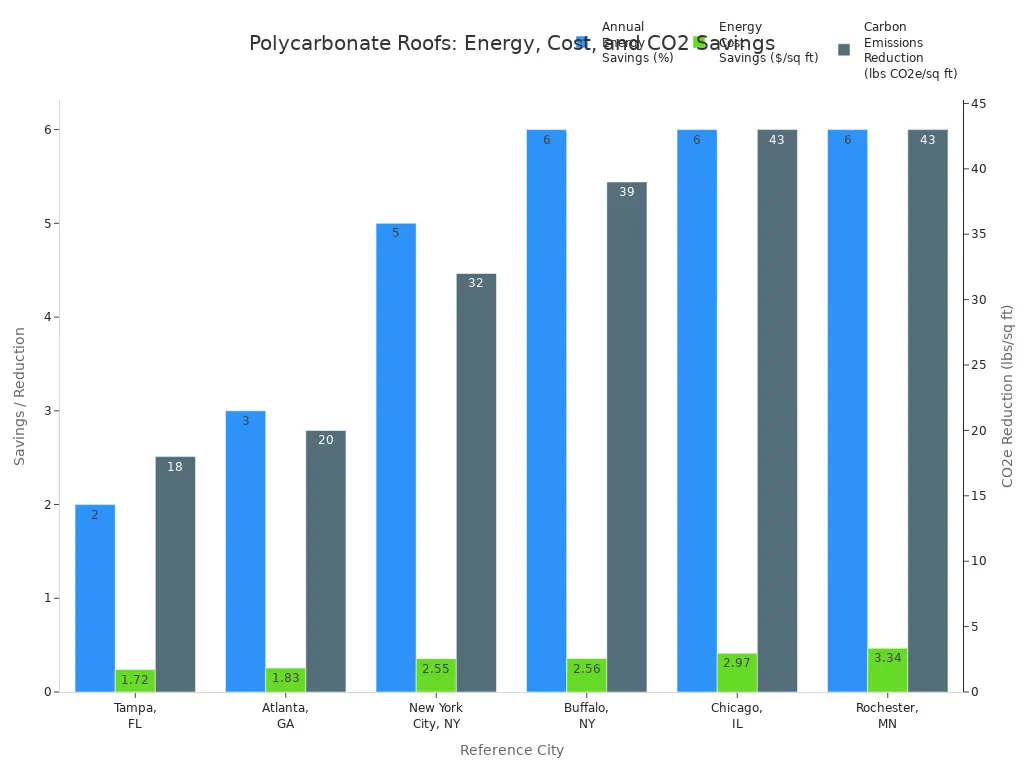
Users praise these roofs for impact resistance, UV protection, and long-lasting performance. As demand for green building practices grows, polycarbonate roofing stands out as a smart, sustainable, and cost-effective solution.
